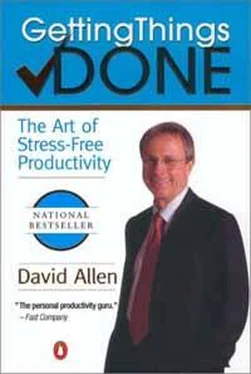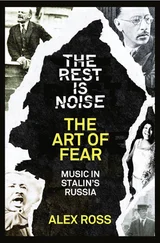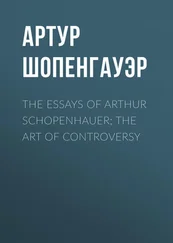What About Things That Are Already on Lists and in Organizers'? You may already have some lists and some sort of organization system in place. But unless you're thoroughly familiar with this workflow-processing model and have implemented it previously, I recommend that you treat those lists as items still to be processed, like everything else in "in." You'll want your system to be consistent, and it'll be necessary to evaluate everything from the same viewpoint to get it that way.
"But I Can't Lose That Thing . . . !" Often in the collection process someone will run across a piece of paper or a document that causes her to say, "Oh, my God! I forgot about that! I've got to deal with that!" It could be a phone slip with a return call she was supposed to handle two days before, or some meeting notes that remind her of an action she was supposed to take weeks ago. She doesn't want to put whatever it is into the huge stack of other stuff in her in-basket because she's afraid she might lose track of it again.
If that happens to you, first ask yourself if it's something that really has to be handled before you get though this initial implementation time. If so, best deal with it immediately so you get it off your mind. If not, go ahead and put it into "in." You're going to get all that processed and emptied soon anyway, so it won't be lost.
If you can't deal with the action in the moment, and you still just have to have the reminder right in front of you, go ahead and create an "emergency" stack somewhere close at hand. It's not an ideal solution, but it'll do. Keep in mind that some potential anxiousness is going to surface as you make your stuff more conscious to you than it's been. Create whatever supports you need.
Start with Your Desktop
Ready now? OK. Start piling those things on your desk into "in."Often there'll be numerous things right at hand that need to go in there. Many people use their whole desktop as "in"; if you're one of them, you'll have several stacks around you to begin your "in"collection with. Start at one end of your work space and move around, dealing with everything on every cubic inch. Typical items will be:
• Stacks of mail and memos
• Phone slips
• Collected business cards
• Notes from meetings
Resist the urge to say, as almost everyone does initially, "Well, I know what's in that stack, and that's where I want to leave it." That's exactly what hasn't worked before, and it all needs to go into the in-basket.
As you go around your desktop, ask yourself if you have any intention of changing any of the tools or equipment there. Is your phone OK? Your computer? The desk itself? If anything needs changing, write a note about it and toss it into "in."
Desk Drawers
Next tackle the desk drawers, if you have them, one at a time. Any attention on anything in there? Any actionable items? Is there anything that doesn't belong there? If the answer to any of these questions is yes, put the actionable item into "in" or write a note about it. Again, whether you use this opportunity to clean and organize the drawers or simply make a note to do it later will depend on how much time you have and how much stuff is in there.
Counter tops
Continue working your way around your office, collecting every-thing sitting on the tops of credenzas or counters or cabinets that doesn't belong there permanently. Often there will be stacks of reading material, mail, and miscellaneous folders and support material for actions and projects. Collect it all.
Maybe there is reference material that you've already used and just left out. If that's so, and if you can return it to the file cabinet or the bookshelf in just a second, go ahead and do that. Be careful to check with yourself, though, about whether there is some potential action tied to the material before you put it away. If there is, put it into "in" so you can deal with it later in the process.
Inside the Cabinets
Now look inside the cabinets. What's in there? These are perfect areas for stashing large supplies and reference materials, and equally seductive for holding deeper levels of stuff. Any broken or out-of-date things in there? Often I'll find collectibles and nostalgia that aren't meaningful to my clients any longer. One general manager of an insurance office, for example, wound up tossing out at least a small Dumpster's worth of "recognition" awards he had accumulated over the years.Again, if some of these areas are out of control and need purging and organizing, write that on a note and toss it into "in."
Floors, Walls, and Shelves
Anything on bulletin boards that needs action? Anything tacked onto the walls that doesn't belong there? Any attention on your pictures, artwork, plaques, or decorations? How about the open shelves? Any books that need to be read or donated? Any catalogs, manuals, or three-ring binders that are out of date or have some potential action associated with them? Any piles or stacks of things on the floor? Just scoot them over next to your in-basket to add to the inventory.
Equipment, Furniture, and Fixtures
Is there anything you want to do to or change about any of your office equipment or furniture or the physical space itself? Does everything work? Do you have all the lighting you need? If there are actionable items, you know what to do: make a note and put it in "in."
Other Locations
Depending on the scope of what you're addressing in this process,you may want to do some version of the same kind of gathering anywhere else you keep stuff. If you're determined to get to a really empty head, it's imperative that you do it everywhere.
Some executives I work with find it immensely valuable to take me home with them and have me walk them through this process there as well. Often they've allowed the "not so important" trap to ensnare them in their home life, and it has gnawed away at their energy.
Don't let the "not so important" trap gnaw away your energy at home.
Mental Gathering: The Mind-Sweep
Once you feel you've collected all the physical things in your environment that need processing, you'll want to collect anything else that may be residing in your psychic RAM. What has your attention that isn't represented by something already in your in-basket?
This is where the stack of plain paper really comes into play. I recommend that you write out each thought, each idea, each project or thing that has your attention, on a separate sheet of paper. You could make one long list on a pad, but given how you will later be processing each item individually, it's actually more effective to put everything on separate sheets. You will likely not keep these pieces of paper (unless you decide that low-tech is your best organizing method), but it'll be handy to have them as discrete items to deal with as you're processing.
It will probably take you between twenty minutes and an hour to clear your head onto separate notes, after you've gathered everything else. You'll find that things will tend to occur to you in somewhat random fashion—little things, big things, personal things, professional things, in no particular order.
In this instance, go for quantity. It's much better to overdo this process than to risk missing something. You can always toss the junk later. Your first idea may be "Save the ozone layer," and then you'll think, "I need cat food!" Grab them all. Don't be surprised if you discover you've created quite a stack of paper in "in" during this procedure.
"Trigger"List
To assist in clearing your head, you may want to review the following "Incompletion Triggers" list, item by item, to see if you've forgotten anything. Often you'll just need a jog to unearth something lurking in a corner of your mind. Remember, when something occurs to you, write it on a piece of paper and toss it into "in."
Читать дальше











